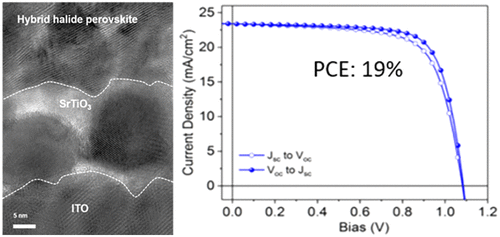
Charge transport layers strongly influence the performance of perovskite solar cells (PSCs). To date, compact layers and mesoporous scaffolds of titanium dioxide have emerged as good electron transport layers (ETL), enabling record power conversion efficiencies (PCE). However, these ETLs require sintering above 400 °C, which excludes them from low-temperature applications such as flexible devices and silicon-heterojunction tandems. Furthermore, instability of TiO2 under prolonged exposure to sunlight appears to be a critical issue. Here, we present the promising characteristics of low-temperature processed strontium titanate (STO) as an ETL to realize PSCs with 19% PCE. STO is a wide bandgap transparent inorganic perovskite. Compared with other low-temperature processed interlayers, STO reduces the parasitic absorption in the ultraviolet and visible range, improves the electron transport, and greatly increases the stability of the devices, retaining ∼80% of their initial efficiency after 1000 h of constant white light illumination.


"KAUST shall be a beacon for peace, hope and reconciliation, and shall serve the people of the Kingdom and the world."
King Abdullah bin Abdulaziz Al Saud, 1924 – 2015
Thuwal 23955-6900, Kingdom of Saudi Arabia
© King Abdullah University of Science and Technology. All rights reserved